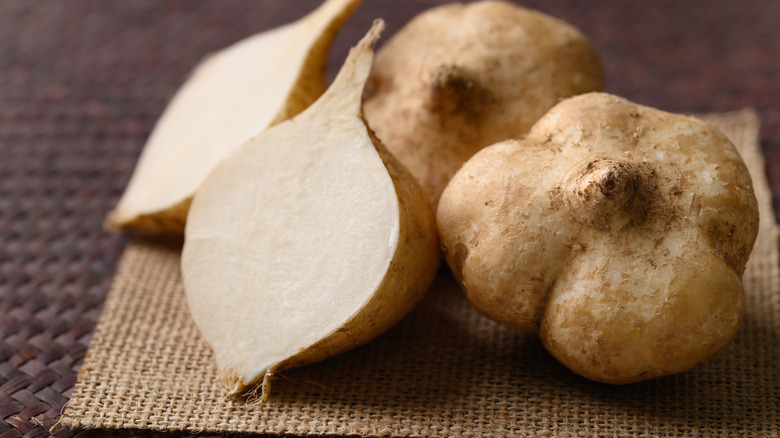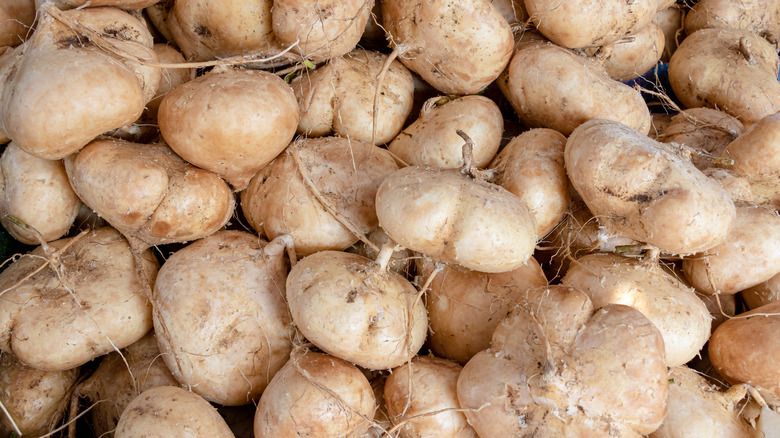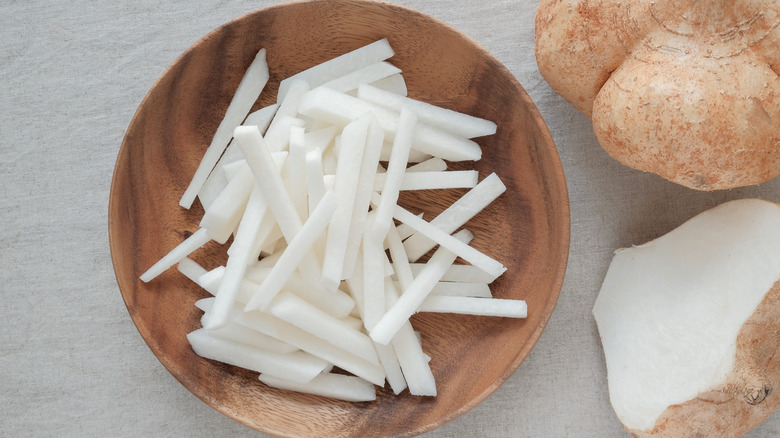Jicama: The Mexican Root Vegetable That's Also A Bean
When you're attempting to categorize fruits and vegetables, it quickly becomes apparent that the rigid categories that we use to differentiate produce are almost laughably limited. Most of you have probably heard that the tomato, which is often lumped in with the veggies due to its inclusion in primarily savory dishes, is actually a fruit, but that is far from the only piece of produce posing as something else.
Plenty of other common foods aren't what you think. Broccoli and cauliflower are both technically vegetables, but can more accurately be categorized as flowers. Avocados, pumpkins, and coffee beans, much like tomatoes, are fruits, as all three foods grow off of a plant and reproduce using seeds. Peas are neither fruits nor vegetables, but legumes, a term broadly applied to the bean family. Another food that is difficult to categorize is jicama, which has its roots in both the vegetable and legume camps.
What is jicama?
While surface dwellers cannot see them on their daily strolls, root vegetables are a hidden treasure trove that soaks up essential vitamins and minerals from the soil. Jicama is a root vegetable native to Central America, and certain parts of northern South America. However, it would not be entirely accurate to say that jicama is a vegetable.
The particular part of jicama that has made its way into cuisine is a root, and therefore a vegetable, but the rest of the plant is a legume. The parts of the plant that aren't the jicama root are toxic, due to the presence of the naturally occurring insect-repellent rotenone. Attempting to categorize jicama taxonomically is difficult enough, but a nomenclatural assessment could prove to be equally as difficult. Jicama has been called sweet turnip, and also Mexican potato.
As you might imagine, a food that is both legume and root vegetable is incredibly nutrient dense. Jicama is packed with fiber and low in calories. It also contains a sizable amount of antioxidants and vitamins.
How you can eat more jicama
Jicama has a mild sweetness and strong snap, and enjoying it raw is probably the best way to enjoy these attributes. You can chop the root into sections and dip them into the sauce of your choosing. Alternatively, jicama can be chopped up for use in the dip itself, as is the case in this easy watermelon salsa recipe. When sliced thin, jicama makes a great receptacle for virtually any food. Jicama sticks, wraps, and salsas are the purview of Jica Foods, a successful snack company that recently earned a $300,000 investment on "Shark Tank."
While raw jicama is the most prevalent form of vegetable, you shouldn't be afraid of cooking it. Essentially every method of preparation, from steaming to sautéeing, works on the resilient root, though jicama can lose some of its trademark crunches if it is cooked for too long. You can also put your jicama tuber in the oven whole for a healthier alternative to the baked potato.


